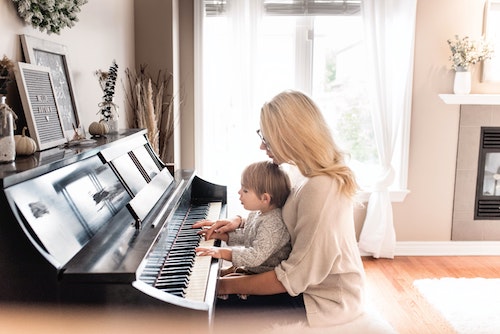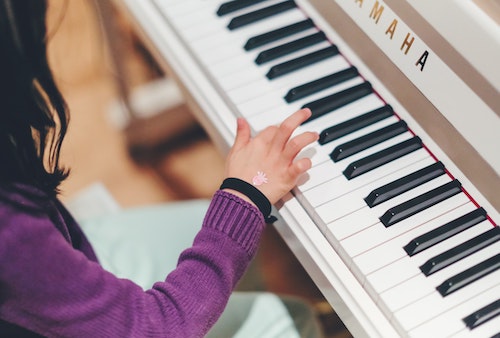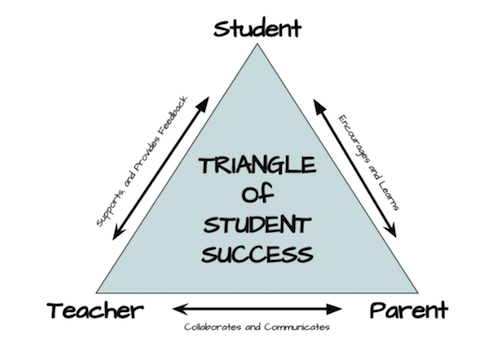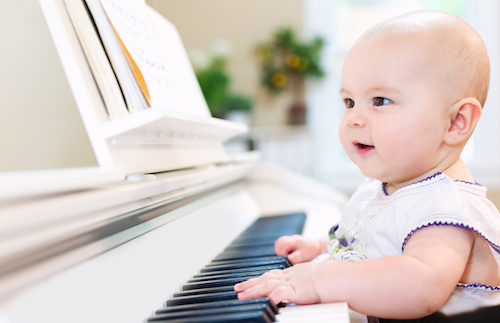Learn about the Suzuki Method and discover why the Nuryl curriculum is the perfect way to give your child a great musical foundation before they begin learning an instrument!

The Power Of Music
Children generally love exploring musical instruments. As babies, they love touching the piano keys or strumming the strings on a guitar and hearing the noises. You can see the fascination in their eyes that they are creating those sounds! Surrounding them with instruments is a great way to get them interested in music and foster a lifetime love and exploration into many different types of music.
Many parents have a deep love for music and want their children to experience that. In these cases, parents often decide to have their child learn an instrument, not only for the love of music that it will foster but also because it has many benefits. Some of these would be:
- Expression through creativity
- Improved social interaction skills
- Increased memory capabilities
- Improved time management skills
- Stress reduction
- Improved patience and perseverance
- Increased confidence
Since playing an instrument involves practically every part of the human brain, it is a great way to “exercise” and stimulate the brain. And we also know that the first six years of a child’s life are the most important in terms of brain development and learning. They are constantly building new brain connections that will ultimately remain for the rest of their lives. A baby’s brain creates over 1 million brain connections every second in those first formidable years.

The Suzuki Method
Once a parent decides to start their child learning an instrument, there are a couple of options.
Traditional music instruction typically begins at around age 5, with music lessons in grade school. The child is introduced to different instruments and learns about simple music theory and rhythms in a group setting. Private instrument lessons outside of school can improve progress.
There is, however, another popular and effective way for a child to learn an instrument to a very high standard called The Suzuki Method.
Initially named The Mother Tongue Approach, this method was created in 1898 by Dr. Shinichi Suzuki. He built upon the concept that young children learn their native languages very quickly through daily immersion, exposure, and focused guidance from their parents.
Dr. Suzuki felt the immersion and parental interaction applied to learning an instrument would help nurture and develop a child’s character.
Young children learn their native languages very quickly through daily immersion and exposure and guidance from their parents. The Suzuki Method applies this immersion and parental interaction to learning an instrument.
There are several important characteristics of the Suzuki Method:
- Parent involvement and encouragement
- Music Immersion
- Constant repetition
- Building upon learned concepts
- Starting the child on an instrument as early as 3yo
The most important aspect of the Suzuki Method is daily parental involvement. The child learns from a Suzuki-certified teacher, and there are specific weekly lessons which the parents will attend.
Both child and parent will learn the theory simultaneously from the teacher by watching and listening. Then while at home, the child will practice their instrument under the direction of their parent. During this home practice, the parent must give the proper encouragement to help drive a positive learning experience. And “parent” in this case can also mean caregiver, guardian, grandparent, and anyone who is caring for the child daily and will be involved in the musical process.
Parents should be highly involved daily and give the proper encouragement to help drive a positive learning experience.
The Suzuki Triangle

Here we have The Suzuki Triangle, which illustrates the connection between student, teacher, and parent. The teacher and parent provide the foundation for the child to learn. Note that during the Suzuki learning process, it is not uncommon for the parent to learn the instrument.
During their time at home, the Suzuki Method stresses that the child is immersed in listening to the Suzuki music repertoire and other music in general. Listening provides a way of learning that is not dependent on visual aspects, such as reading notes on a page. Out of this listening repetition, they improve their memorization skills. They become familiar with the notes, scales, rhythms, and melodies when performing these songs on their instrument, especially for the Suzuki music pieces.
This method is just as effective for learning music as it was for them to learn their native language!
In addition to private teacher-led instruction, the children will participate in group lessons and performances when they are ready. This team cooperation fosters a bond between the child and their fellow performers, instilling a sense of pride. It helps them learn to perform with others and participate in peer review. It also motivates the child to maintain their discipline to perform better and helps them support others’ efforts.
The Suzuki Instruments
While most children start learning the piano, guitar, or violin, the Suzuki Method covers a wide variety of additional instruments:
- Accordion
- Bass
- Brass Instruments (Trumpet, Trombone, Tuba, Euphonium and French Horn)
- Cello
- Flute
- Harp
- Organ
- Piano
- Recorder
- Violin and Viola
- Voice
You can purchase a single book or complete sets of the books for each instrument your child learns. Keep in mind that your child will spend a lot of time even on the first book. It is not uncommon for a child to remain in Volume 1 for 2-4 years as they master the songs, but of course, it depends on how quickly their skill level is improving.
The number of volumes also differs for each instrument. For example, the violin method has ten volumes, the piano method has seven, and the guitar method has ten.
The Suzuki Music
Beginning with Volume 1, the music selections are simple nursery rhymes and traditional folk songs like Twinkle Little Star, Lightly Row, and Go Tell Aunt Rhody. There are also short pieces written by Johann Sebastian Bach and Shinichi Suzuki. As the child progresses through the curriculum, the later songs in Volume 1 progressively get more complex. New skills build on those already learned.
Songs progressively get more complex. New skills build on those already learned.
The later Suzuki volumes include much more complex pieces in the form of full Concertos and Sonatas. Constant repetition in playing these pieces is critical here, as the teacher and parent will give feedback on the child’s performance. Then they can then use it to improve their playing as they attempt it again. Continued review is integral to the Suzuki Method!
Since learning music is by listening with no sight-reading, one sees how this method fosters improved memory and other cognitive skills.
Benefits of the Suzuki Method
Of course, the main goal of this method is to learn an instrument but there are other benefits gained from the Suzuki Method over traditional methods.
- Teaches listening skills through repetition, which could develop into relative and perfect pitch
- Taught to learn full pieces of music earlier rather than just playing scales and learning mini technical exercises.
- Teaches cooperation through group practice and performances
- Helps develop self-esteem through public performances
- No visual aspect of music to learn first.
- Instills and fosters a love of music
While it is true that younger children have more sensitive ears, which makes it a better time to learn an instrument, the Suzuki Method stresses that it is never too late to start. Teens and adults of any age are encouraged to learn an instrument through this method.
It is worth noting that many highly acclaimed professional musicians started their musical training through the Suzuki Method. Nuryl’s CEO, Mike von Grey, started each of his four daughters on the Suzuki method at a very young age. They became exceptional musicians who formed their own musical group and toured nationally in the US.
Many highly acclaimed professional musicians started their musical training through the Suzuki Method.

Nuryl and the Suzuki Method
The Nuryl curriculum shares many of the same principles of the Suzuki Method, such as parent involvement, music immersion, repetition, and of course, starting your child listening to music at an early age. The Suzuki Method stresses that beginning a child’s musical journey during their early years is vital for developing mental processes and muscle coordination. However, they suggest starting them on an instrument no earlier than three years old. Before this point, a child doesn’t have enough cognitive development to begin the process.
The Nuryl app can fill this early time and provide an excellent musical foundation. It will expose your child to musical pieces from which they can become familiar with complex music, beautiful melodies, and following along with rhythms. The musical lessons we provide will also give them an early introduction to the 24 different keys. Our lullaby playlist will then soothe them to sleep after a long day of learning and exploration.
We highly recommend that parents interact with their children during their Nuryl time by bouncing and dancing to the beat of the music to help the child stay focused and promote active listening. And they can start listening to the Nuryl curriculum as early as 5 months prenatal and continue right up until age 3 when they should start their instrument training.
Through Nuryl, your child will already be familiar with music that will give them a significant head-start towards learning their first instrument!
The Nuryl curriculum shares many of the same principles of the Suzuki Method, such as parent involvement, music immersion, repetition, and of course, starting your child listening to music at an early age.
Getting Your Child Started
When you feel the time is right to get your child started learning an instrument, the best way to get started is to find a Suzuki-certified instructor in your area. It is an essential step since this will be a long-term relationship. If you live in the US or Canada, you can use the link below from the Suzuki Association of America to find a teacher near you, and they can direct you on the best way to proceed.
Find a Suzuki Teacher (the USA and Canada)
If you live internationally, you can search for certified Suzuki instructors in your area or contact the International Suzuki Association for help.
International Suzuki Association
Some teachers will recommend that you sit in on a group performance before getting started, and if so, make sure to observe the relationship between the teacher and students. Specifically, you want to watch the level of standards the teacher is expecting and the respect they show towards their students. It would be best to ask the teacher about their expectations for your child AND you as parents who will oversee their lessons. Also, ask other students and parents how they feel about a specific instructor to help narrow down your decision.
A Great Combination!
Overall, the Suzuki Method has proven to be a successful way for any child to learn an instrument. Many people believe it is THE most effective musical training that one can undergo. The inherent concept of this method shows that having musical abilities is not just something a child is born with but rather that any child can learn to master a musical instrument.
According to Dr. Suzuki, “The potential of every child is unlimited!”. Then pair this with the early brain-stimulating curriculum of Nuryl, and you have a potent musical learning combination.


[…] Learning an instrument can help improve concentration, can help improve spatial reasoning skills and relieves stress. To learn more, read our blog on introducing your child to an instrument here as well as the Suzuki Method here. […]